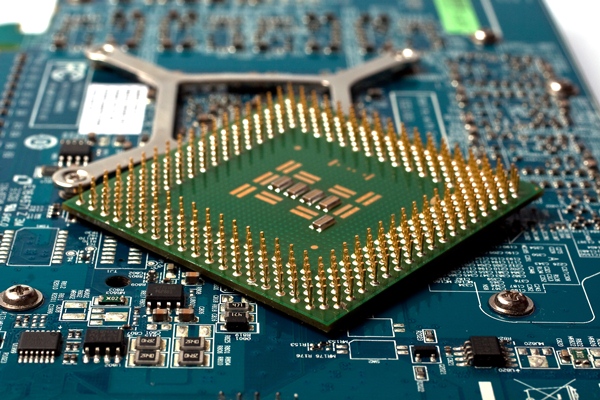China's push to become a world leader in high-tech industries has one neighbor particularly worried about new competition on the block: South Korea.
中国正在努力寻求成为高科技产业的世界领导者,这样的野心引起了邻国韩国的忧虑。韩国担心自己会迎来新的竞争对手。
In China's new economic blueprint unveiled during the Two Sessions, known as the 13th Five-Year Plan, Chinese officials identified semiconductors as a potential tech sector to dominate. That has raised an alarm in South Korea's semiconductor industry, the world's largest after the U.S. with an 18 percent global market share.
在“两会”上公布的中国新经济蓝图(即十三五规划)中,中国官员表示,确定将半导体这个具有巨大潜力的技术作为新的发展方向。这一决定引起了韩国半导体业的恐慌。韩国是仅次于美国的世界第二大半导体生产商,占全球市场份额的18%。

At present, China commands just 3 percent of the global semiconductor market share but Beijing is hoping to increase that figure as part of its plan for new services industries, dubbed "New China," to bolster gross domestic product (GDP). Aside from semiconductors, "New China" sectors also include chip materials, robotics, aviation equipment and satellites.
目前,虽然中国在全球半导体市场上只占有3%的份额,但中国希望增加这一比例,并将这作为其全新服务产业(即“新常态”计划)的一部分,从而提高GDP水平。此外,除了半导体产业,该计划还涉及芯片材料、机器人、航空设备和卫星等多个领域。
Officials intend to achieve that goal by increasing the share of spending on research and development (R&D) to 2.5 percent of GDP for the 2016-2020 period, from 2.1 percent in 2011-2015, according to the new Five-Year Plan.
中国官员表示,根据新的五年计划,在2016年-2020年期间,相关领域的研发资金将由2011年-2015年占GDP的2.1%增加至2.5%。
"China's announcement has of course not remained unnoticed, especially by large players in high-tech industries," economists at investment bank Natixis remarked in a report.
著名投行法国外贸银行的经济专家在一份报告中指出,“国际社会其实已经注意到了中国在这方面的发展,特别是几家高科技领域的巨头们。”
"Its aggressive push is worrying for [South] Korea's industrial giants. If we consider that Korea's major global comparative advantage is high-tech electronics, such threat becomes a systemic threat for the country's economic future."
“中国的积极行动让韩国的工业巨头们忧心不已。鉴于韩国在全球的主要竞争优势在于其高科技电子产品,中国的这一举动对韩国的未来经济造成了系统性威胁。”
South Korea's semiconductor industry is certainly paying attention. A day after the new Five-Year Plan was announced, Korea's Semiconductor Industry Association (KSIA) urged President Park Geun-Hye's government to counter the new market threat.
韩国半导体产业对此密切关注。就在中国“十三五规划”公布的第二天,韩国半导体产业协会便要求总统朴槿惠制定措施应对新的市场威胁。
"I thought that China had attempted to invest only in the semiconductor industry but it seems that China has gone a step further," KSIA Chairman Park Sung-wook was quoted as saying, referring to Beijing's aspirations to become a major semiconductor maker.
对于中国有志成为半导体制造大国的雄心,韩国半导体产业协会主席朴星昱近日表示:“我原以为中国只是试图投资半导体产业,但没想到中国比这还更近了一步。”
Leading Korean producers such as Samsung and SK Hynix should be worried, Natixis argues, citing three key factors.
法国外贸银行认为,这样的现状的确应该引起三星和海力士等韩国主要制造商的重视,并给出了三个重要原因。
Heavy consumption
强大的消费力
China is already the largest consumer of semiconductors globally, which should support its domestic producers, Natixis explained.
法国外贸银行解释称,中国已成为世界最大的半导体消费国,这会为其国内的半导体生产商提供支持。
"This is particularly relevant for Korean firms since they serve the Chinese market in quite a massive way."
“这与韩国公司紧密相关,因为中国原本是他们的一个巨大市场。”
After Intel, Samsung and SK Hynix are the biggest semiconductor suppliers in the Chinese market.
在中国市场,三星与海力士是仅次于英特尔的第二大和第三大半导体供应商。
China is South Korea's largest trading partner and the exchange of goods between the two nations is set to ramp up in the wake of last year's Korea-China Free Trade Agreement.
中国是韩国最大的贸易伙伴。去年,两国签订了《中韩自由贸易协定》,这将会促进两国之间的贸易量进一步增长。
A bottom-down model
以市场为主导
Beijing has also unveiled new steps that demonstrate its commitment to becoming a semiconductor superpower.
中国还公布了一些新的措施,显示了它想成为半导体产业超级大国的决心。
China has strived to become a global player for a decade now but it hasn't achieved success thus far due to its insistence on a state-led centralized approach to industrial development, Natixis said. Now, officials are embracing a more market-oriented method that encourages competition and allows companies to tap public funds to buy expertise abroad.
法国外贸银行称,中国为成为全球半导体产业领导者努力了十年,但并未取得成功。原因在于此前中国一直采取国家主导的方式控制产业发展,如今中国更多地采用市场主导的方式 ,鼓励竞争,允许企业利用公共资本购买国外技术。
For example, China created the National Integrated Circuit Industry Equity Investment Fund in 2014, endowing it with $18.4 billion. Moreover, the Ministry of Industry and Information Technology intends to spend $153 billion over the next decade to support the semiconductor sector - the bulk of which will be spent on buying expertise from foreign competitors, according to Natixis.
法国外贸银行在报告中举例称,2014年,中国设立了国家集成电路产业股权投资基金,注资184亿美元。此外,工业和信息化部计划在未来十年内投入1530亿美元支持半导体领域,其中大部分资金将用于从国外竞争对手手中购买专业技术。
"This obviously increases China's competitive threat [to Korea] in as far as they are able to execute appropriate merger & acquisition (M&A) deals in this sector."
“中国在这个领域进行的合并与收购交易,很显然加大了对韩国的竞争威胁。”
Chinese investors have already started snapping up semiconductor assets. Last year, a consortium of China private equity firms snapped up U.S. firm Omnivisions Technologies for $1.9 billion in cash while a separate group of Chinese investors bought Nasdaq-listed Integrated Silicon Solution for $640 million.
中国投资者们已经开始抢购半导体资产。去年,一家中国民营企业以19亿美元现金收购了美国豪威科技公司。另一拨中国投资者以6.4亿美元的价格收购了纳斯达克上市公司——芯成半导体有限公司。
Shift to mobile
转向移动领域
Lastly, Korean semiconductor manufacturers tend to focus more on computers rather than mobile handsets, demand for which is growing at a faster clip. Because China dominates mobile demand, it is ideally placed to profit from semiconductor growth.
此前,韩国半导体制造商更注重电脑领域而非移动设备,而移动设备领域正在以更快的速度发展。中国对移动设备的半导体需求是最大的,这也将为半导体产业的发展带来了可观的利润。
Samsung Electronics and SK Hynix are the world leaders in DRAM chips, key for personal computers, so as demand for those chips decline, semiconductor profits at both firms have slowed in recent quarters, Natixis said.
法国外贸银行还说,三星电子和海力士是世界存储芯片制造商的领导者。该芯片是个人电脑的核心组件。因此,随着对这些芯片需求的减少,这两家半导体公司近几个季度的利润增长也随之放缓。
"Samsung and other Korean firms will need to push to achieve competitiveness in a higher tech level due to the changing nature of demand for chips as well as China's push for technology gains."
“由于芯片需求的改变以及中国的科技野心,三星与其他韩国企业需要提高科技水平,以应对竞争。”












